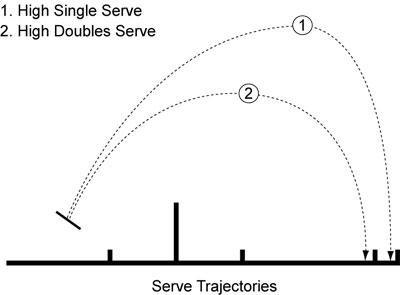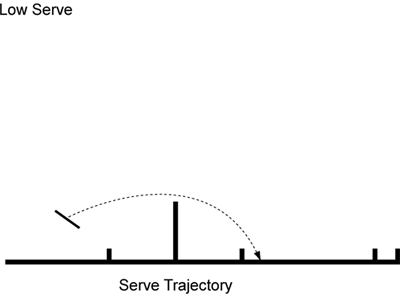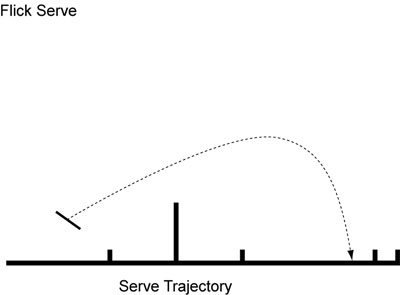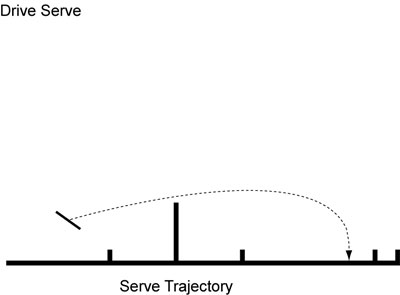To be successful in the game of badminton, one must master the serve. You must keep your opponent guessing on which type of serve you are going to use and where you will place it.
The badminton serve is a big part of the strategy. There are a few different kinds of serves: the high serve, low serve with your forehand or backhand, flick serve, and drive serve. You want to master them all, so you do not give easy points to your opponent.
The whole rally starts from the serve and serving well gives the player the upper hand right from the beginning. This is the reason why this is essential.
It is crucial to know when to use which kind of serve. There is a picture where you can see how the shuttlecock flies in each serve.
High Serve
This badminton serve is used when you want to open the opponent’s court. This is a great serve in singles but has to be used carefully in doubles.
- Stand a relaxed couple of feet behind the service line and bend your knees.
- Lead with your non-racket leg.
- Put your racket near your shoulder level.
- Hold the shuttle by its feathers and let it drop slightly in front of you.
- Hit the shuttle with the racket’s face.
The high serve is mostly used during singles play to move your opponent as far back into the court as possible. You use your forehand grip and stand a few feet behind the service line to execute this serve. Bend your knees and extend your racket to almost shoulder level.
Be sure to follow through back into the ready position when the shuttle has been hit. Because of the proximity to the backline, many players hit this serve out.
Don’t aim for the backline, but aim to hit it high towards the ceiling, thus eliminating the chance of a flat serve. It would help if you also placed high serves towards the middle of the court and not the corners.

Low Serve
This badminton serves you want to use when you want the opponent to lift the shuttlecock. It is recommended when the opponent’s attack is strong. This serve is commonly used in doubles. You can serve the low serve both forehand and backhand.
Forehand
- Relax your body and bend your knees.
- Stand a couple of feet behind the short service line.
- Place your racket leg behind.
- Keep the racket on to your waist level and hold the shuttlecock by the feathers close to the racket (do not drop it in front).
- Push the shuttle bit higher but below your waistline.
- Aim to the tape of the net and make the shuttle skim from it.
TIP: Mix the way you serve and catch your opponent off guard.
Backhand
- Stand relaxed with your racket hand in front.
- Lead with your racket leg.
- The backswing should be short.
- It would be best if you held the shuttle in the waistline.
- Aim to the tape of the net and make the shuttle skim from it.
TIP: Shorten the grip to have better control of the racket
The low serve is most often used in doubles play when you want your opponent to lift the shuttle. You can also use this serve if your singles opponent’s attack is too dominant. To execute this serve, you can either use the forehand grip or backhand grip.
To use your forehand grip, have your racket at waist level before you begin your swing. Contact the shuttle below your waistline, and push it forward so that it just makes it over the tape of the net.
To perform a low serve with your backhand, use a short backswing before contacting the shuttle at waist level. Again be sure the shuttle clears the top of the tape to catch your opponent off guard.
This serve is sent directly at your opponent, giving them fewer angles to return the shuttle. (For better control and feel, you can shorten your grip on the backhand low serve).
The low serve should only be played when you can react quickly to the return. This serve usually sets up for netplay, and fast reflexes and quick footwork are a must.

Flick Serve
It is all about the wrist motion and executing this serve without the opponent anticipating it. This badminton serve starts the same as low serve, but then the wrist movement comes in and hopefully surprises the opponent.
Flick serve is used when an opponent has momentum and is on the attack. It is mostly used in doubles because if your opponent in the singles play knows you will use it, it can leave you vulnerable for an attack/smash return.
The key to this serve is all in the wrist action, on either your backhand or forehand. It is a deceptive serve that gives the impression you will perform a low serve, but then at the last moment, you flick your wrist to propel the shuttle over. Stand close to the service line, unlike the other serves, and try to hit it above your opponent’s backhand out of their reach.

Drive Serve
The main point with this badminton serve is to attack. The result may be a bad return from the opponent, which gives you a great opportunity, or it could lead straight to gaining the point.
This is quite the same as high serve, but instead, if aiming up, the player makes the shuttle go horizontally.
A drive serve is considered an attacking serve and can be used successfully in singles or doubles competition. The shuttle moves in a flatter arch than the other serves, and if you catch your opponent off guard, it can lead to an unforced error.
The forehand grip is used for this serve, following through at waist level to contact the shuttle. Use a lot of force to contact the shuttle and send it hard across the net.
It can limit your follow-through, and your racket face stays square with the net. Unlike the high serve, you should play the flick serve to the corners to create a greater movement for your opponent.

All these are great ways to serve, but the main thing is to use different ways and keep the opponent guessing what you are about to do next.
The Basics of Short Serving
Being able to do a short service is very important in a normal doubles game. And increasingly so in singles as well. Here are some tips I would like to share with anyone who thinks short service is difficult or believes it’s easy and has taken it for granted.
1. For beginners:
Aim at the nettop (the white tape) rather than aiming at the floor (or any line). Good short service does not require the shuttlecock to land at a particular spot. It is more important to make sure it goes (and just) over the net.
It means that you have to control your power such that once the shuttlecock goes over the top of the net, it should start falling. Most beginners can begin to short serve relatively well with this approach within half an hour of practice.
2. Understand some physics:
Based on a simple law of physics, as long as you are standing and hitting the shuttlecock behind your own service line, the shuttlecock (if it can go over the net) should land beyond the service line of the receiver’s side, as both service lines are the same distance to the net. So again, you don’t need to worry about the service line on the other side. Just focus on the top of the net.
3. Some more physics:
Higher may not be better: Some players prefer to serve with the racquet/shuttlecock impact point as high as possible (even higher than their waist, which is a fault) to shorten the distance between the impact point and the net.
It sounds good and logical, but it makes the shuttlecock travel relatively flat, even after crossing the net, which allows the receiver to return the shuttlecock with a quick drive or flick shot. The truth is, higher does not equate to better, particularly when you are facing a good net-rusher.
Therefore, a serve with a lower impact point is, in fact, a safer serve. With the deeper falling angle, it’s more difficult for the receiver to attack your serve by flicking or driving the shuttlecock. The lower point of impact is safer.
4. Use different parts of your racquet when serving:
One other law of physics to consider – the shuttle is subject to the laws of air friction. Air resistance will help to make the shuttlecock fall faster. Believe me, if you are standing close enough to the centerline, about 6 to 10 inches away from your own service line, a T to T straight short serve should always land properly.
When you try to serve towards the sideline, you will need to serve harder by swinging your racquet faster to compensate for the air resistance. But this faster swing will give away your intention to the receiver.
You can try a technique to use the higher part (nearer to the tip) of your racquet to hit the shuttlecock. The same swing (same movement) will help propel the shuttlecock further, to the sidelines or wherever you wish the shuttle to land – with a slight adjustment in power.
Further Discussion On The Serves
A weak serve in your game can be the difference between winning and losing your match, so it’s important to work on this, one of the key badminton techniques.
A poor or weak serve will give your opponent a big opportunity to attack and use and an aggressive shot, so below, we’ll look at the different types of badminton serve to help you improve your game.
Low, just-above-the-net Serve
One of the best badminton tips for serving is using a low serve, which will land the shuttlecock in front of your opponent. The shuttlecock must drop just behind the net when using this shot to avoid your opponent easily smashing it back at you.
It doesn’t matter whether you choose to land the shuttlecock on your opponent’s backhand or forehand side, as neither will require them to move their feet a great deal.
Master these badminton skills:
Hold the shuttlecock head down, slightly angled towards you. Put your racquet behind the shuttlecock and step forward a touch with your leading leg. Flick your racquet with your wrist in the direction of the shuttlecock, using this power to launch the shuttlecock.
High, way-over-the-net Serve
The high serve is another of the best badminton tips and is used when you want to catch an opponent and take advantage of their poor footwork by landing the shuttlecock behind them.
A high serve executed properly will mean that your opponent cannot smash the shuttlecock back to you with force. This is especially true if you aim for your opponent’s backhand, as it is usually the case that this will be weaker than the forehand.
If the opponent struggles and tries to use their forehand, they have to move further from their starting position, allowing you to exploit the rest of the court with your next shot.
Remember that for you to have both a strong backhand and forehand and not be caught out by your opponent using the high serve, address both in your badminton training.
Master these badminton skills:
Hold the shuttlecock with its head facing directly down to the ground. Stand to the side of the shuttlecock and swing your arm, which is holding your racquet upwards and then flick your wrist and racquet in the direction you want the shuttlecock to land.
Final thought
Consider the strengths and weaknesses of your opponent when choosing which serve to use. If your opponent is tall, for instance, then they may be easily able to return a high serve powerfully so that a low serve may be the better bet.
Also, examine their footwork, how strong they are on their backhand as oppose to their forehand, etc. Exploit their weaknesses as you learn more about them throughout the game.
